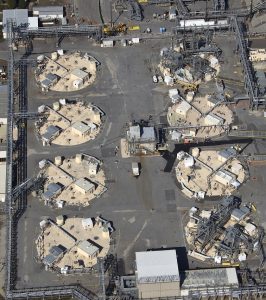
As SRS aims to fill more high-level waste tanks with “grout,” the U.S. Nuclear Regulatory Commission submits an analysis on the approach DOE took with in-situ tank closure of Tank 12H. So far, 8 of 51 high-level waste tanks have been “closed” at SRS, which means they have been emptied of most nuclear waste and are cemented in place, a lasting and leaking tribute to the folly of plutonium production for nuclear weapons. The tanks were filled with by-product high-level nuclear waste from separation of weapon-grade plutonium, produced by irradiating “targets” in the 5 production reactors at SRS, and from production of other nuclear materials.
NRC document posted on December 3, 2020: “TECHNICAL REVIEW: U.S. DEPARTMENT OF ENERGY DOCUMENTATION RELATED TO TANK 12H GROUTING OPERATIONS WITH EMPHASES ON SPECIFICATIONS, TESTING, RECOMMENDATIONS AND PLACEMENT PROCEDURES (PROJECT NO. PRO0734),” November 18, 2020
The U.S. Nuclear Regulatory Commission (NRC) has performed a technical review of several
documents prepared by the U.S. Department of Energy (DOE) that provide information on
grouting and closure of Tank 12H in 2016. The focus of NRC’s technical review is grout
formulations and specifications, testing, recommendations and placement procedures.
Proper tank grouting is important to several factors for effective long-term performance of the
closed tank farms, including chemical conditioning of the water infiltrating into the tanks before
contact with the waste layers, stability of the vessels (including filling of void space) and
reducing the probability of inadvertent intrusion (e.g., the thick concrete and grout could alert an
inadvertent intruder to stop drilling before reaching the waste layer).
The NRC staff concludes that performance requirements for the tank grout formulation
recommended and tested for Tank 12H closure are generally consistent with initial bulk
chemical and hydraulic properties assumed in DOE’s H-Area Tank Farm Facility Performance
Assessment (PA) (SRR-CWDA-2010-00128). However, DOE has not provided sufficient
information and testing to support its exclusion of shrinkage gaps, cracks, and other preferential
flow pathways through the grout monolith from the reference case in DOE’s PA.
The NRC staff expects DOE to provide additional information related to the extent and
performance impact of tank grout shrinkage to support a reasonable assurance decision that the
performance objectives specified in 10 CFR Part 61, Subpart C are met.
No open issues resulted from this technical review. However, insufficient information is
provided to address the likelihood for preferential flow pathways that enable bypass flow to form
through grout monoliths due to shrinkage, cracking, and void space. NRC staff will continue to
follow-up on this technical issue under 3.2 “Groundwater Conditioning via Reducing Grout,” and
Monitoring Factor 3.3, “Shrinkage and Cracking” (See ADAMS Accession No. ML15238A761).
full summary memo & technical review: NRC on grouting tank 12H Nov 18 2020 sent Dec 3 ML20296A550
Photo: SRS high-level waste tank “farm”